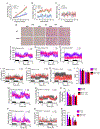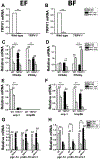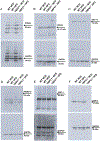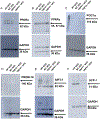Mice lacking endogenous TRPV1 express reduced levels of thermogenic proteins and are susceptible to diet-induced obesity and metabolic dysfunction
- PMID: 33977527
- PMCID: PMC8277693
- DOI: 10.1002/1873-3468.14105
Mice lacking endogenous TRPV1 express reduced levels of thermogenic proteins and are susceptible to diet-induced obesity and metabolic dysfunction
Abstract
Transient receptor potential vanilloid subfamily 1 (TRPV1) is a non-selective cation channel protein expressed in neuronal and non-neuronal cells. Although TRPV1 is implicated in thermogenesis and diet-induced obesity (DIO), its precise role remains controversial. TRPV1-/- mice are protected from DIO, while TRPV1 activation enhances thermogenesis to prevent obesity. To reconcile this, we fed wild-type and TRPV1-/- mice for 32 weeks with normal chow or a high-fat diet and analyzed the weight gain, metabolic activities, and thermogenic protein expression in white and brown fats. TRPV1-/- mice became obese, exhibited reduced locomotor activity, reduced energy expenditure, enhanced hepatic steatosis, and decreased thermogenic protein expression in adipose tissues. Our data reveal that lack of TRPV1 does not prevent obesity, but rather enhances metabolic dysfunction.
Keywords: TRPV1−/−; adipose tissue; adiposity; fatty liver; metabolism; obesity.
© 2021 Federation of European Biochemical Societies.
Conflict of interest statement
Statement of Competing Interest
The authors have no competing interests.
Figures






Similar articles
-
TRPV1 activation counters diet-induced obesity through sirtuin-1 activation and PRDM-16 deacetylation in brown adipose tissue.Int J Obes (Lond). 2017 May;41(5):739-749. doi: 10.1038/ijo.2017.16. Epub 2017 Jan 20. Int J Obes (Lond). 2017. PMID: 28104916 Free PMC article.
-
Capsaicin induces browning of white adipose tissue and counters obesity by activating TRPV1 channel-dependent mechanisms.Br J Pharmacol. 2016 Aug;173(15):2369-89. doi: 10.1111/bph.13514. Epub 2016 Jun 21. Br J Pharmacol. 2016. PMID: 27174467 Free PMC article.
-
A role for TRPV1 in influencing the onset of cardiovascular disease in obesity.Hypertension. 2013 Jan;61(1):246-52. doi: 10.1161/HYPERTENSIONAHA.112.201434. Epub 2012 Nov 12. Hypertension. 2013. PMID: 23150506
-
Flavonoids, Potential Bioactive Compounds, and Non-Shivering Thermogenesis.Nutrients. 2018 Aug 25;10(9):1168. doi: 10.3390/nu10091168. Nutrients. 2018. PMID: 30149637 Free PMC article. Review.
-
On the evolutionary origins of obesity: a new hypothesis.Endocrinology. 2014 May;155(5):1573-88. doi: 10.1210/en.2013-2103. Epub 2014 Feb 26. Endocrinology. 2014. PMID: 24605831 Review.
Cited by
-
Remodeling of Adipose Tissues by Fatty Acids: Mechanistic Update on Browning and Thermogenesis by n-3 Polyunsaturated Fatty Acids.Pharm Res. 2023 Feb;40(2):467-480. doi: 10.1007/s11095-022-03377-w. Epub 2022 Sep 1. Pharm Res. 2023. PMID: 36050546 Review.
-
An Overview of the TRP-Oxidative Stress Axis in Metabolic Syndrome: Insights for Novel Therapeutic Approaches.Cells. 2022 Apr 11;11(8):1292. doi: 10.3390/cells11081292. Cells. 2022. PMID: 35455971 Free PMC article. Review.
-
Capsaicin directly promotes adipocyte browning in the chemical compound-induced brown adipocytes converted from human dermal fibroblasts.Sci Rep. 2022 Apr 22;12(1):6612. doi: 10.1038/s41598-022-10644-8. Sci Rep. 2022. PMID: 35459786 Free PMC article.
-
The interaction of TRPV1 and lipids: Insights into lipid metabolism.Front Physiol. 2022 Dec 15;13:1066023. doi: 10.3389/fphys.2022.1066023. eCollection 2022. Front Physiol. 2022. PMID: 36589466 Free PMC article. Review.
-
Dynamics of Fatty Acid Composition in Lipids and Their Distinct Roles in Cardiometabolic Health.Biomolecules. 2025 May 10;15(5):696. doi: 10.3390/biom15050696. Biomolecules. 2025. PMID: 40427589 Free PMC article. Review.
References
-
- Li L et al. (2012). TRPV1 activation prevents nonalcoholic fatty liver through UCP2 upregulation in mice. Pflugers Arch 463, 727–32. - PubMed
-
- Zhang LL et al. (2007). Activation of transient receptor potential vanilloid type-1 channel prevents adipogenesis and obesity. Circ Res 100, 1063–70. - PubMed
-
- Yoneshiro T, Aita S, Kawai Y, Iwanaga T and Saito M (2012). Nonpungent capsaicin analogs (capsinoids) increase energy expenditure through the activation of brown adipose tissue in humans. Am J Clin Nutr 95, 845–50. - PubMed
Publication types
MeSH terms
Substances
Grants and funding
LinkOut - more resources
Full Text Sources
Other Literature Sources
Medical
Molecular Biology Databases

